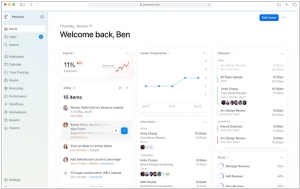StarTeam vs Subversion
October 02, 2024 | Author: Michael Stromann
0★
StarTeam brings world-class agile change management to organizations with multiple repositories. Streamline workflows by connecting tools, processes and teams via a single repository. StarTeam maintains and tracks changes to source code, defects and features, to gain control over distributed and collaborative development. Maintain visibility and traceability across your software assets.
3★
Apache Subversion is a version control system distributed as open source under the Apache License. Software developers use Subversion to maintain current and historical versions of files such as source code, web pages, and documentation. Subversion exists to be universally recognized and adopted as an open-source, centralized version control system characterized by its reliability as a safe haven for valuable data; the simplicity of its model and usage; and its ability to support the needs of a wide variety of users and projects, from individuals to large-scale enterprise operations.
Ah, version control systems. The unsung heroes of software development, standing between order and chaos, ensuring that what you did yesterday won't spontaneously combust today. Enter StarTeam and Subversion—two titans of the version control cosmos, each swaggering about with their own sense of self-importance and an impressive array of shiny buttons to press.
First up, StarTeam. Created by Borland, then scooped up by Micro Focus in the way one might acquire a particularly temperamental houseplant, StarTeam is the textbook definition of a *centralized* version control system. Everything—your code, your version histories, your carefully crafted metadata—lives on one grand, central server. That’s right, a single point of glorious failure! It’s the kind of system that gives managers peace of mind because they can control everything from a cozy, centralized console. But heaven help you if the server goes down. When it does, much like a kettle without water, nothing much happens.
Now, Subversion—SVN, for the acronymally inclined—also calls itself a centralized system, but does so with a more casual shrug, as if to say, "Yes, centralized, but not *that* centralized." It’s the laid-back cousin of StarTeam, offering a simpler, more accessible interface that even developers who still think ‘Git’ is something rude can figure out. SVN is particularly proud of its ability to handle branching and merging, which sounds like a botanical lesson but is actually vital for allowing several developers to mess around in the same codebase without accidentally creating a Frankenstein’s monster of software bugs. It’s like an efficient, cooperative ant colony, as opposed to StarTeam’s more top-down, monarchic beehive.
And then, of course, there’s the matter of licensing. Subversion is the wild, untamed beast of the open-source world—free as the wind and just as unpredictable. It's supported by a community that exists on the fringes of digital society, constantly tinkering, improving and occasionally breaking things in the name of progress. StarTeam, however, comes with a proprietary license, which is a fancy way of saying, "You’ll have to pay for this and no, you can’t just change things as you like." For some, this is a comfort—a kind of corporate security blanket that says, "Don’t worry, we’ve got this." For others, it’s like paying rent for the privilege of living in a very well-decorated prison cell.
See also: Top 10 Source Code Management tools
First up, StarTeam. Created by Borland, then scooped up by Micro Focus in the way one might acquire a particularly temperamental houseplant, StarTeam is the textbook definition of a *centralized* version control system. Everything—your code, your version histories, your carefully crafted metadata—lives on one grand, central server. That’s right, a single point of glorious failure! It’s the kind of system that gives managers peace of mind because they can control everything from a cozy, centralized console. But heaven help you if the server goes down. When it does, much like a kettle without water, nothing much happens.
Now, Subversion—SVN, for the acronymally inclined—also calls itself a centralized system, but does so with a more casual shrug, as if to say, "Yes, centralized, but not *that* centralized." It’s the laid-back cousin of StarTeam, offering a simpler, more accessible interface that even developers who still think ‘Git’ is something rude can figure out. SVN is particularly proud of its ability to handle branching and merging, which sounds like a botanical lesson but is actually vital for allowing several developers to mess around in the same codebase without accidentally creating a Frankenstein’s monster of software bugs. It’s like an efficient, cooperative ant colony, as opposed to StarTeam’s more top-down, monarchic beehive.
And then, of course, there’s the matter of licensing. Subversion is the wild, untamed beast of the open-source world—free as the wind and just as unpredictable. It's supported by a community that exists on the fringes of digital society, constantly tinkering, improving and occasionally breaking things in the name of progress. StarTeam, however, comes with a proprietary license, which is a fancy way of saying, "You’ll have to pay for this and no, you can’t just change things as you like." For some, this is a comfort—a kind of corporate security blanket that says, "Don’t worry, we’ve got this." For others, it’s like paying rent for the privilege of living in a very well-decorated prison cell.
See also: Top 10 Source Code Management tools




